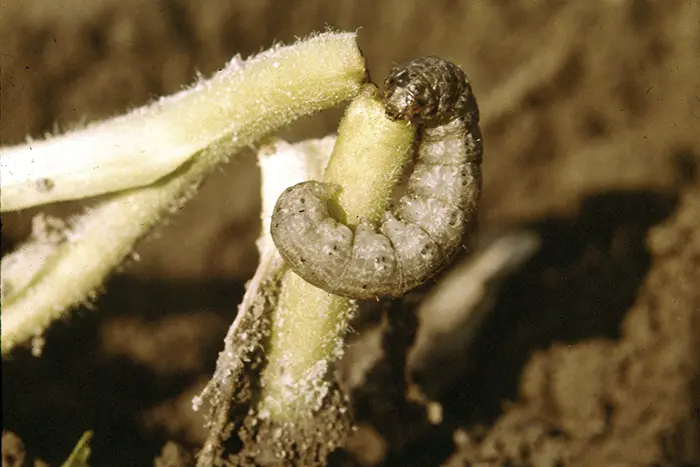Beautiful Plants For Your Interior
Cutworms: Identify, Prevention and Control

Cutworms are a common pest in gardens and agricultural fields, causing damage to a wide variety of plants. In the following post, we will explore the different types of cutworms, their life cycle, and various methods for managing and controlling these destructive pests.
Common Names
A Cutworm is the ‘caterpillar’ stage of multiple species of moths. They are called ‘cutworms’ because they ‘cut down’ young plants as they feed on stems. Some of the most common types of ‘cutworm’ include the Variegated cutworm (Peridroma saucia), Black cutworm (Agrotis ipsilon), Turnip moth, (Agrotis segetum), and Army cutworm (Euxoa auxiliaries).
Plants Affected
These garden pests can cause serious damage to a wide range of plants, including vegetables, fruits, flowers, and ornamental plants. Seedlings are most susceptible to ‘cutworm’ feeding, but cutworms can also feed on the leaves of low-growing herbaceous plants. In summer, cutworms can feed on lettuce roots, potato tubers, and other root vegetables in the vegetable garden.
Main Symptoms
The main symptom of cutworm damage is the sudden wilting and death of young plants. These garden pests cut through the plant stem at or just below the soil surface, causing the plant to fall over. They also feed above ground at ‘night’ whenever the weather is mild, particularly on the leaves of low-growing herbaceous plants. However, the damage caused by these pests can sometimes be confused with that caused by slugs, vine weevils, chafer grubs, and voles.
The Culprits
Only the larvae of ‘cutworms’ damage plants. The adults of all ‘cutworm’ species are night-flying moths with wingspans from 1.5-3in (30-75mm). Adult moths feed off the nectar of wild and cultivated flowers. Full-grown larvae are 1-2in (25-50mm) long, soft, plump, hairless caterpillars whose colour and markings vary from greyish white to tan, brown, charcoal grey, or even black. Some species are also ‘subterranean’ and eat roots.
Timing
Cutworms are most active in the Spring and early Summer, but they can also be active in the Autumn. The moths lay their eggs in the soil or on plant material during the Summer months. The tiny round eggs start off white before turning brown. The eggs hatch within 1 to 3 weeks. Like the adult moths, the ‘cutworms’ also vary in appearance.

Cutworm Larve Damage Plants by ‘Cutting’ Through Stems
Prevention and Management
Cultural Controls (Non-Chemical)
The most effective way to prevent ‘cutworms‘ is by practising cultural controls. You can start by removing any debris and weeds from your garden, as ‘cutworms’ tend to hide in such places.
You can also ’till’ the soil before planting to expose the ‘cutworms’ to predators (birds for instance) or the elements. Another way to prevent these pests is by using ‘cardboard or plastic collars’ (see video below) around the base of your plants. This will act as a barrier and prevent them from reaching the plant stems.
Organic Controls
Biological control is another effective way to manage a cutworm infestation. You can encourage predators such as birds or parasitic wasps into your garden to feed on the cutworms. Nematodes are also useful in controlling this pest. These microscopic ‘worms’ attack the ‘cutworms’ in the soil and prevent them from causing damage to your plants. You may be able to purchase Nematodes from your local garden centre or get Nematodes online.
You can also use a ‘soap flush’. A ‘soap flush’ is a simple method for ‘identifying’ insects in your lawn or garden beds by mixing dish detergent and water to create a solution that irritates insects in the soil, forcing them to emerge to the surface.
Mix one tablespoon of lemon dish soap with 1 gal (4 ltr) of water and pour it on your garden soil. The ‘pests’ will emerge, and you can then remove them by hand.
You can also use neem oil, which is extracted from the seeds of the ‘neem tree’ and is toxic to a wide range of insects, including cutworms. It can be mixed with water and sprayed on the plants.
Chemical Controls
If cultural and biological controls fail, you can resort to ‘chemical’ controls. Pesticides such as ‘Bacillus thuringiensis‘ (Bt) are effective in controlling cutworms. Bacillus thuringiensis is a bacteria that is toxic to ‘cutworms’ but harmless to humans and pets. You can also use pheromone traps to attract and trap the male moths, preventing them from mating and laying eggs.
It is important to note that pesticides should only be used as a last resort and applied according to the manufacturer’s instructions. Organic options are available and should be considered before using chemical pesticides. Always wear protective clothing when handling pesticides and store them out of reach of children and pets.
By following these prevention and management techniques, you can effectively control and manage cutworms in your garden.
Some Practical Ways to Deal With Cutworms By Making DIY Collars
FAQ’s
When is the best time to apply control measures for cutworms?
It’s best to apply control measures in the early spring before the larvae hatch and begin feeding on plants. Regular monitoring of plants is also essential for early detection and control.
What plants are most at risk from cutworm damage?
Cutworms are known to attack a variety of plants, including tomatoes, peppers, corn, and other vegetable seedlings, as well as young transplants.
Do cutworms overwinter in colder climates?
Some species of cutworms overwinter as pupae in the soil and emerge as moths in the spring, while others may overwinter as larvae.
Can mulching help prevent cutworm damage?
Yes, applying a layer of mulch around plants can create a barrier that makes it more difficult for these pests to access the stems of seedlings.
Are there any companion plants that can help deter cutworms?
Plants such as marigolds, dill, and calendula are known to repel cutworms and can be used as companion plants to help protect vulnerable crops.
